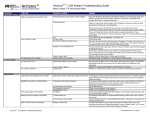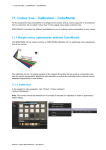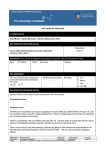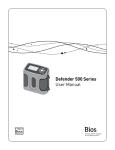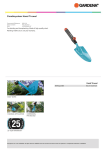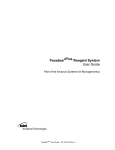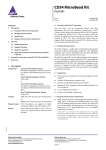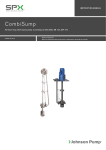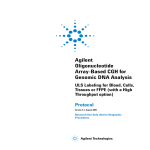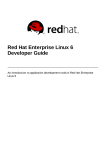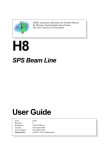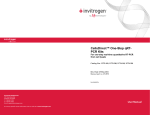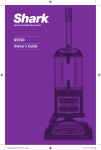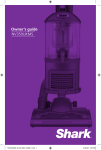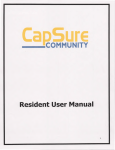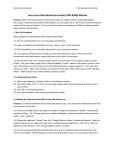Download Cell sample submission
Transcript
Guidelines for Cell sample submission Different cell sample sources can be submitted for the microarray analysis, from cell lines to cell-type-specific samples derived from flow and magnetic sorting. In cases where only limited cell numbers are achieved by cell sorting, the SuperAmp™ Service, in combination with the Agilent Whole Genome Microarray platform, provides the possibility of performing reliable microarray analyses. The SuperAmp™ Technology is also the prerequisite for gene expression profiling of cells obtained by Laser Capture Microdissection (LCM), a demanding starting material, due to the low number of selected cells. Agilent Whole Genome Microarray Service: 1×10⁵–1×10⁷ cells Overview Quick-frozen cell pellets from adherent cells 1. Cell samples • Quick-frozen cell pellets from adherent cells • Quick-frozen cell pellets from suspension cells • Homogenized cell lysates • Stabilized cell samples 2. Separated cells 3. Separated cells with limited cell number (< 10,000) for SuperAmp™ Service 4. Cell samples derived from Laser Capture Microdissections (LCM) for SuperAmp™ Service • PALM CombiSystem (Carl Zeiss) • A rcturusXT™ Laser Capture Microdissection System (Applied Biosystems) The protocols indicated above are commonly used by our Microarray Service team, and we therefore recommend following these if possible. However, if you need information about alternative methods, please contact your local genomic service specialist via the contact form on www.miltenyibiotec.com/genomic-services-contact. Below are the equired numbers of cells for the different microarray platforms: Agilent Whole Genome aCGH Microarray Service: 1×10⁶–5×10⁶ cells, 300–500 µL whole blood aliquots miRXplore™ Microarray Service: 1×10⁶–5×10⁶ cells Agilent microRNA Microarray Service: 1×10⁵–1×10⁶ cells 1. Cell samples • R emove cell culture medium by aspiration and wash adherent cells once with cold PBS • D etach cells with trypsin and / or EDTA, stop trypsinization by adding medium, and transfer samples to a tube • P ellet the cells by centrifugation at an appropriate centrifugal force, such as 100–500×g for 5 minutes at 4°C. Make sure that cells do not get damaged during centrifugation. Carefully aspirate the supernatant • ( Optionally: Wash cells by adding cold PBS. Spin down the washed cells at an appropriate centrifugal force, such as 100–500×g for 5 minutes at 4°C. Carefully aspirate the supernatant) • Q uick-freeze cell pellet by complete submersion in liquid nitrogen for at least 15 seconds TRIZOL® cell lysis as alternative to trypsin treatment: • C ells can be directly lysed in a culture dish by adding 1 ml of TRIZOL® Reagent (Invitrogen) to a 3.5 cm diameter dish, and passing the cell lysate through a pipette several times. The amount of TRIZOL® Reagent added is based on the area of the culture dish (1 mL per 10 cm²) and not on the number of cells present. An insufficient amount of TRIZOL® Reagent may result in contamination of the isolated RNA with DNA • Store quick-frozen cell pellets or cell lysates at –80°C • Ship quick-frozen cell pellets or cell lysates on dry ice Quick-frozen cell pellets from suspension cells OR • Transfer cells to a tube • Separate cells by using flow cytometry • P ellet the cells by centrifuging at an appropriate centrifugal force such as 100–500×g for 5 minutes at 4°C. Make sure that cells do not get damaged during centrifugation. Carefully aspirate the supernatant • T ransfer cells to a tube. Pellet the cells by centrifuging at an appropriate centrifugal force such as 100–500×g for 5 minutes at 4°C. Make sure that cells do not get damaged during centrifugation. Carefully aspirate the supernatant • ( Optionally: Wash cells by adding cold PBS. Spin down the cells for 5 minutes at an appropriate centrifugal force and aspirate supernatant completely) • Q uick-freeze cell pellet by complete submersion in liquid nitrogen for at least 15 seconds • Store quick-frozen cell pellets at –80°C • Ship quick-frozen cell pellets on dry ice Homogenized cell lysates • Transfer cells to a tube • P ellet the cells by centrifuging at an appropriate centrifugal force such as 100–500×g for 5 minutes at 4°C. Make sure that cells do not get damaged during centrifugation. Carefully aspirate the supernatant • L yse the cells directly by adding RLT buffer (Qiagen) or RA1 buffer (Macherey-Nagel) according to the respective User manual or 1 mL TRIZOL® Reagent (Invitrogen) • Store cell lysates at –80°C • Ship cell lysates on dry ice Stabilized cell samples If liquid nitrogen is not available, RNAprotect Cell Reagent (Qiagen) can be used to stabilize RNA in cell samples. For further information about correct handling and storage conditions, refer to the manufacturer’s protocol. • S torage conditions for stabilized cell samples: 1 day at 37°C, 7 days at 15–25°C, or 4 weeks at 2–8°C; samples can be archived at –20°C or –80°C. The provider recommends lower temperatures whenever possible (e.g., 2–8°C instead of RT) • Ship stabilized cell samples on cool packs (4°C) 2. Separated cells Techniques such as flow or magnetic sorting provide the possibility of obtaining highly enriched and pure cell fractions, which in turn allow cell-type-specific microarray analyses to be performed. MACS® Technology MACS® Technology has become the standard method for cell separation. Based on MACS MicroBeads, it is possible to perform cell separations with consistent high-quality results for frequently occurring cells, rare cells, and sophisticated subsets. This reliable cell separation procedure can easily be standardized and used in an automated fashion with the autoMACS® Pro Separator. In general: • S eparate cells with MACS Technology using the appropriate MicroBeads, manually or in an automated fashion by using the autoMACS® Pro Separator • Q uick-freeze cell pellet by complete submersion in liquid nitrogen for at least 15 seconds • Store separated blood cell samples at –80°C • Ship separated blood cell samples on dry ice Amount of starting material for MACS® Separation using MicroBeads: Since the required amounts of the different starting materials can vary by MicroBead type, please refer to the information specifically relevant to your needs at www.miltenyibiotec.com/cell-separation-reagents. 3. Separated cells with limited cell number (< 10,000) for SuperAmp™ Service Even limited cell numbers resulting from cell separation can be further analysed by using the SuperAmp™ Service. This service is intended for samples of < 10,000 cells, and includes delivery of SuperAmp™ Preparation Kit for sample lysis and storage. Biological replicates are very important when the amount of starting material is limited, as biological differences between individual cells (e.g. cell cycle status) can be more easily balanced. Furthermore, experimental conditions should be carefully controlled in order to minimize noise from variations in sample preparation or biological variation. The SuperAmp™ Service requires you to supply your samples in SuperAmp Tubes provided. The cells to be analyzed are lysed in 6.4 µL Lysis Buffer, and the volume of the cells should be adjusted before lysis to 1 µL with no more than 10,000 cells / µL. If possible, samples should be lysed directly in the SuperAmp Tubes, since transferring samples from tube to tube may lead to loss of material. In general: • L yse samples with the SuperAmp Lysis Buffer according to the guidelines provided in the SuperAmp Preparation Kit • Store SuperAmp Lysates at –20°C • S hip SuperAmp Lysates on dry ice in the SuperAmp Tube Container provided Amount of starting material for SuperAmp™ Service: < 10,000 cells Further information and protocols can be found in the “SuperAmp Preparation Kit” datasheet that is sent together with the kit after receiving an order. 4. Cell samples derived from Laser Capture Microdissections (LCM) for SuperAmp™ Service Isolation of single cell populations is a prerequisite for successful description of cell-type specific gene expression. Because they result in higher RNA quality and recovery, we recommend using sections from cryoconserved tissues rather than FFPE sections. The limited cell numbers resulting from LCM can be further analysed using the SuperAmp™ Service; at least 100 cells should be dissected. Biological replicates are very important when the amount of starting material is limited, as biological differences between individual cells (e.g. cell cycle status) can be more easily balanced. Furthermore, experimental conditions should carefully be controlled in order to minimize noise from variations in sample preparation or biological variation. The appropriate sample preparation protocols for the different LCM devices, including preparation of slides, mounting of samples onto the slides, staining procedures, and storage conditions, are described in the respective manuals. The sample collection for the SuperAmp™ Service is described below for the PALM MicroBeam (Carl Zeiss) and the ArcturusXT™ Laser Capture Microdissection System (Applied Biosystems). ArcturusXT™ Laser Capture Microdissection System (Applied Biosystems) According to the ArcturusXT™ Laser Capture Microdissection System User guide, it is recommended to use the ExtraSure® Extraction Device and place it on the CapSure HS Cap containing the microdissected cells. The dissected cells should be collected within the black capture ring because of the fitting of the ExtraSure device onto the Capsure HS Cap. The cells can be directly lysed after collection by using the SuperAmp Lysis Buffer provided with the SuperAmp™ Preparation Kit: • A ssemble the CapSure HS Cap and the ExtraSure® Extraction Device according to the ArcturusXT™ Laser Capture Microdissection System User guide • A dd 10 µL of freshly prepared SuperAmp Lysis Buffer to the device and pipette the buffer up and down 10–20 times; in addition, try to detach the cells mechanically by scratching with the tip over the surface to make sure that the cells are accessible to lysis • P lace a 0.5-mL microcentrifuge tube over the fill port and perform cell lysis for 10 minutes at 45°C • P lace the tube into a microcentrifuge and spin briefly to bring the cell lysate to the bottom of the tube • Store SuperAmp Lysates at –80°C • S hip SuperAmp Lysates on dry ice in the SuperAmp Tube Container provided PALM MicroBeam (Carl Zeiss) According to the PALM MicroBeam user manual, the “dry” collection procedure using the manufacturer’s Adhesive Caps is recommended. The microdissected cells are instantly immobilized by the filling of the caps. It is important not to centrifuge the dissected cells in this dry state since this may not be sufficient to recover them at the bottom of the tube. The cells can be directly lysed after collection by using the SuperAmp Lysis Buffer provided with the SuperAmp™ Preparation Kit: • A dd 10 µL of freshly prepared SuperAmp Lysis Buffer to the microdissected cells in the cap and pipette the buffer up and down 10–20 times; in addition, try to detach the cells mechanically by scratching with the tip over the surface to make sure that the cells are accessible to lysis • F or cell lysis, incubate tube upside down for 10 minutes at 45°C • Centrifuge tubes at 2,500×g for 1 minute at RT • Transfer cell lysate to the SuperAmp tubes provided • Store SuperAmp Lysates at –80°C • S hip SuperAmp Lysates on dry ice in the SuperAmp Tube Container provided Miltenyi Biotec provides products and services worldwide. Visit www.miltenyibiotec.com/local to find your nearest Miltenyi Biotec contact. autoMACS, MACS, miRXplore, and SuperAmp are either registered trademarks or trademarks of Miltenyi Biotec GmbH. All other trademarks mentioned in this document are the property of their respective owners and are used for identification purposes only. Unless otherwise specifically indicated, Miltenyi Biotec products and services are for research use only and not for therapeutic or diagnostic use. Copyright © 2011 Miltenyi Biotec GmbH. All rights reserved.




